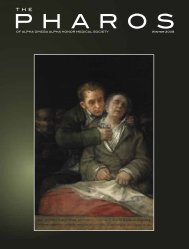Download The Pharos Winter 2011 Edition - Alpha Omega Alpha
Download The Pharos Winter 2011 Edition - Alpha Omega Alpha
Download The Pharos Winter 2011 Edition - Alpha Omega Alpha
Create successful ePaper yourself
Turn your PDF publications into a flip-book with our unique Google optimized e-Paper software.
accepted as the international standard<br />
preparation of insulin. That 1<br />
milligram of this standard contains<br />
8 units of insulin (or 1 unit = 0.125<br />
milligrams), as provisionally defined<br />
by the Insulin Committee of the<br />
University of Toronto. 8p61<br />
<strong>The</strong> League of Nations’ Permanent<br />
Commission on Biological Standards<br />
subsequently adopted this recommendation.<br />
In doing so, the insulin unit<br />
was transformed from being defined by<br />
rodent convulsions to one determined<br />
by comparison to an internationally<br />
recognized standard preparation, in<br />
milligrams.<br />
Over the next decade, decreases<br />
in the use of the standard preparation<br />
method and further advances<br />
in insulin purification led world authorities<br />
to seek a new standard insulin<br />
unit. 10 In 1935, the League of<br />
Nations Permanent Commission on<br />
Biological Standardisation “accepted<br />
the new standard for international<br />
use and redefined the unit of insulin<br />
as the specific insulin activity of one<br />
twenty-second (1/22) of a milligramme<br />
of the new standard.” 11p486 A Third and<br />
Fourth International Standard would<br />
be elucidated under the World Health<br />
Organization, United Nations’ equivalent<br />
to the League of Nations Health<br />
Organization. Remarkably similar to the<br />
1935 standard, the Fourth International<br />
Standard defines biologically extracted<br />
insulin as 24.0 insulin units per milligram.<br />
10<br />
<strong>The</strong>refore, more than eighty years<br />
after a unit-milligram equivalency was<br />
first created to ensure international insulin<br />
standardization, this concept was<br />
resurrected to simplify inhaled insulin<br />
dosing and administration in a new<br />
form. Tables on Pfizer’s Exubera web<br />
site and in print aided clinicians and<br />
their patients in making this contemporary<br />
unit-to-milligram conversion<br />
(Pfizer’s web page for Exubera has been<br />
removed; a web page with similar information<br />
is referenced). 12 In doing so,<br />
they also brought to mind a historical<br />
definition—that of the insulin unit itself.<br />
Henry H. Dale.<br />
Courtesy of the National Library of Medicine. F. Netter, compliments Armour Laboratory, Chicago.<br />
Acknowledgment<br />
I thank my faculty advisors Stephanie<br />
Brown-Clark, MD, PhD, and Michael Green,<br />
MD, MSc, for their thoughtful comments,<br />
guidance, and support in preparation of this<br />
manuscript.<br />
References<br />
1. Bliss M. <strong>The</strong> Discovery of Insulin.<br />
Chicago: <strong>The</strong> University of Chicago Press;<br />
1982.<br />
2. Murnaghan JH, Talalay P. H. H.<br />
Dale’s account of the standardization of<br />
insulin. Bull Hist Med 1992; 66: 440–50.<br />
3. Banting FG, Best CH, Collip JB, et<br />
al. <strong>The</strong> effect of pancreatic extract (insulin)<br />
on normal rabbits. Am J Physiol 1922; 62:<br />
162–76.<br />
4. Sinding C. Making the unit of insulin:<br />
Standards, clinical work, and industry,<br />
1920–1925. Bull Hist Med 2002; 76: 231–70.<br />
5. Sansum WD, Blatherwick NR, Smith<br />
FH, et al. <strong>The</strong> treatment of diabetes with<br />
insulin. J Metab Res 1923; 3: 641–65.<br />
6. Miles AA. Biological standards and<br />
the measurement of therapeutic activity. Br<br />
Med Bull 1951; 7: 283–91.<br />
7. Cockburn WC. <strong>The</strong> international<br />
contribution to the standarization of biological<br />
substances. I. Biological standards<br />
and the League of Nations 1921–1946. Bio-<br />
logicals 1991; 19: 161–69.<br />
8. Knaffl-Lenz E, League of Nations<br />
Health Organisation Permanent Commission<br />
on Standardization of Sera, Serological<br />
Reactions and Biological Products.<br />
Memoranda on Cardiac Drugs, Thyroid<br />
Preparations, Ergot Preparations, Filix<br />
Mas, Suprarenal Preparations, Vitamins,<br />
Pituitary, Salvarsan, Oil of Chenopodium,<br />
Insulin. III. Health. 1928 III. 10. Geneva:<br />
Publications of the League of Nations; 1928.<br />
9. Aufricht H. Guide to League of Nations<br />
Publications: A Bibliographical Survey<br />
of the Work of the League, 1920–1947. New<br />
York: Columbia University Press; 1951.<br />
10. Lacey AH. <strong>The</strong> unit of insulin. Diabetes<br />
1967; 16: 198–200.<br />
11. Best CH, Dale HH. I. Insulin. 1. <strong>The</strong><br />
new international insulin standard and the<br />
re-definition of the existing unit in terms<br />
therof. League of Nations Q Bull Health Org<br />
1936; 5: 584–658.<br />
12. Exubera (Insulin Human [rDNA origin])<br />
Drug Information: Uses, Side Effect,<br />
Drug Interactions and Warnings at RxList.<br />
http://www.rxlist.com/exubera-drug.htm.<br />
<strong>The</strong> author’s address is:<br />
5221 Town Walk Drive<br />
Hamden, Connecticut 06518<br />
E-mail: barry.fields@yale.edu<br />
<strong>The</strong> <strong>Pharos</strong>/<strong>Winter</strong> <strong>2011</strong> 33














